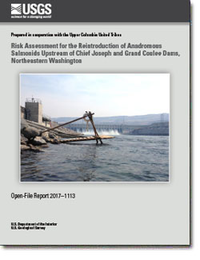Risk assessment for the reintroduction of anadromous salmonids upstream of Chief Joseph and Grand Coulee Dams, Northeastern Washington
Links
- Document: Report (1.4 MB pdf)
- Download citation as: RIS | Dublin Core
Abstract
The Upper Columbia United Tribes (UCUT; Spokane, Colville, Kootenai, Coeur d’Alene, and Kalispel Tribes) and Washington Department of Fish and Wildlife want to reintroduce anadromous salmonids to their historical range to restore ecosystem function and lost cultural and spiritual relationships in the upper Columbia River, northeastern Washington. The UCUT contracted with the U.S. Geological Survey to assess risks to resident taxa (existing fish populations in the reintroduction area upstream of Chief Joseph and Grand Coulee Dams) and reintroduced salmon associated with reintroduction. We developed a risk assessment framework for reintroduction of anadromous salmonids upstream of Chief Joseph and Grand Coulee Dams. To accomplish this goal, we applied strategies identified in previous risk assessment frameworks for reintroduction. The risk assessment is an initial step towards an anadromous reintroduction strategy. An initial list of potential donor sources for reintroduction species was developed from previous published sources for Chinook Salmon (Oncorhynchus tshawytscha) donors in the Transboundary Reach of the Columbia River, British Columbia; an ecological risk assessment of upper Columbia River hatchery programs on non-target taxa of concern; and a review of existing hatchery programs
During two workshops, we further identified and ranked potential donor sources of anadromous Redband Trout (steelhead; O. mykiss), Chinook Salmon, Sockeye Salmon (O. nerka), and Coho Salmon (O. kisutch). We also identified resident fish populations of interest and their primary habitat, location, status, and pathogen concerns to determine the potential risks of reintroduction. Species were deemed of interest based on resource management and potential interactions (that is, genetics, competition, and predation) with introduced species. We developed tables of potential donors by species and characterized potential sources (hatchery and natural origins), populations (individual runs), broodstock management and history, and potential constraints (that is, Endangered Species Act [ESA] listing, Evolutionarily Significant Unit concerns, pathogens, and availability). During the workshops, a group of regional fisheries and topic experts subjectively ranked the relative risks of pathogens, genetic effects, predation, and competition to resident fish and reintroduced salmonids. We assessed the pathogen risk of each potential donor for introducing new pathogens and the increased burden to existing pathogens for resident species upstream of the dams. We considered genetic risks to resident and downstream conspecifics and ecological impacts, including competition for food and space, predator-prey interactions, and ecosystem benefits/impacts. Each reintroduced species donor source was ranked based on abundance/viability (demographic risk to source and feasibility of collection), ancestral/genetic similarity (evolutionary similarity to historical populations), local adaptation (geographic proximity/similarity of source conditions to reintroduction conditions), and life history compatibility (including migration; spawn timing; and relative usage of reservoir, main-stem, or tributary habitats) with environmental conditions in the reintroduction area. We synthesized this information by species for all potential donors, in which an overall score and ranking system was established for decision support in donor selection for reintroduction into the upper Columbia River. We also provided information outside the ranking process by:
- Identifying predator-prey interactions and competition for food and space among species,
- Developing a decision support framework for donor selection, and
- Providing decision support for reintroduction strategies.
Suggested Citation
Hardiman, J.M., Breyta, R.B., Haskell, C.A., Ostberg, C.O., Hatten, J.R., and Connolly, P.J., 2017, Risk assessment for the reintroduction of anadromous salmonids upstream of Chief Joseph and Grand Coulee Dams, northeastern Washington: U.S. Geological Survey Open-File Report 2017 -1113, 87 p., https://doi.org/10.3133/ofr20171113.
ISSN: 2331-1258 (online)
Study Area
Table of Contents
- Executive Summary
- Introduction
- Geographic Area of Interest
- Methods
- Results
- Discussion
- Summary
- Acknowledgments
- References Cited
- Glossary
- Appendixes A–C
| Publication type | Report |
|---|---|
| Publication Subtype | USGS Numbered Series |
| Title | Risk assessment for the reintroduction of anadromous salmonids upstream of Chief Joseph and Grand Coulee Dams, Northeastern Washington |
| Series title | Open-File Report |
| Series number | 2017-1113 |
| DOI | 10.3133/ofr20171113 |
| Publication Date | September 12, 2017 |
| Year Published | 2017 |
| Language | English |
| Publisher | U.S. Geological Survey |
| Publisher location | Reston, VA |
| Contributing office(s) | Western Fisheries Research Center |
| Description | vi, 87 p. |
| Country | United States |
| State | Washington |
| Other Geospatial | Columbia River Basin, Colville Reservation, Spokane Reservation |
| Online Only (Y/N) | Y |


